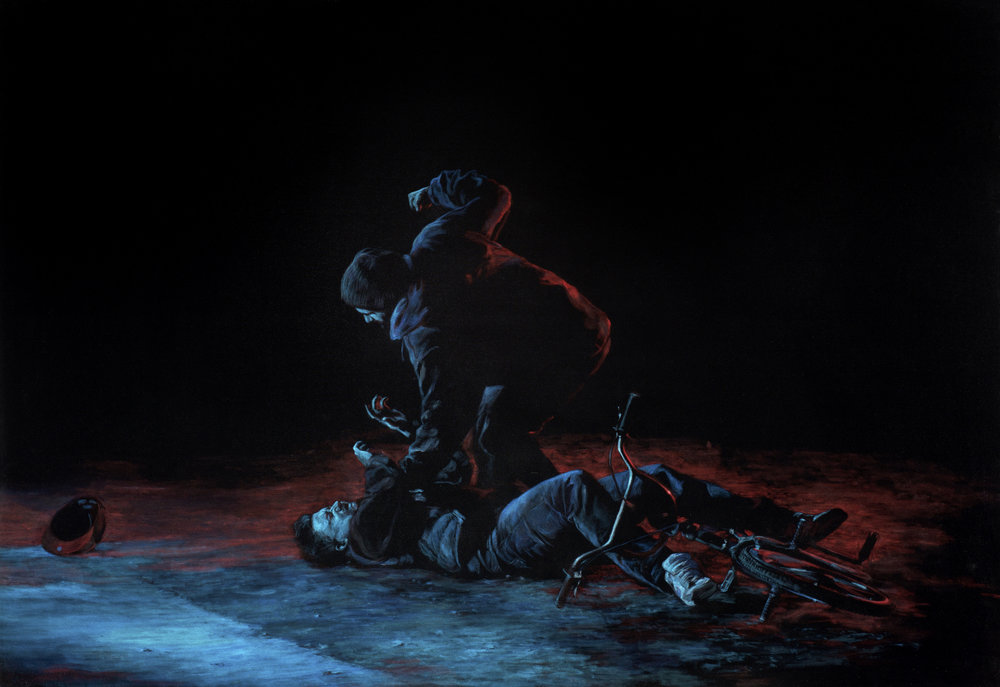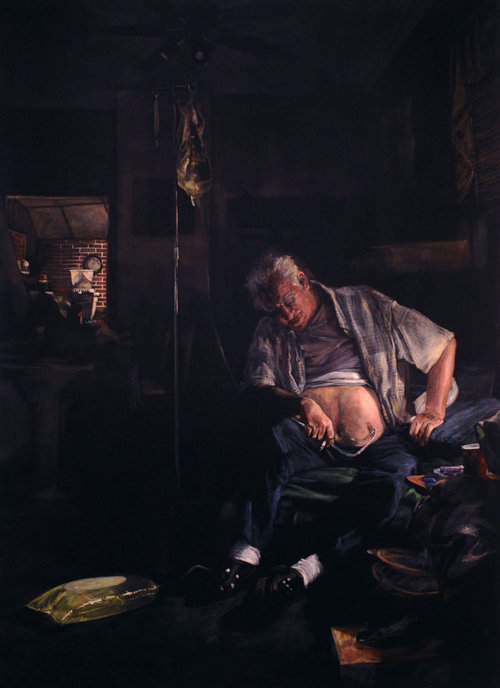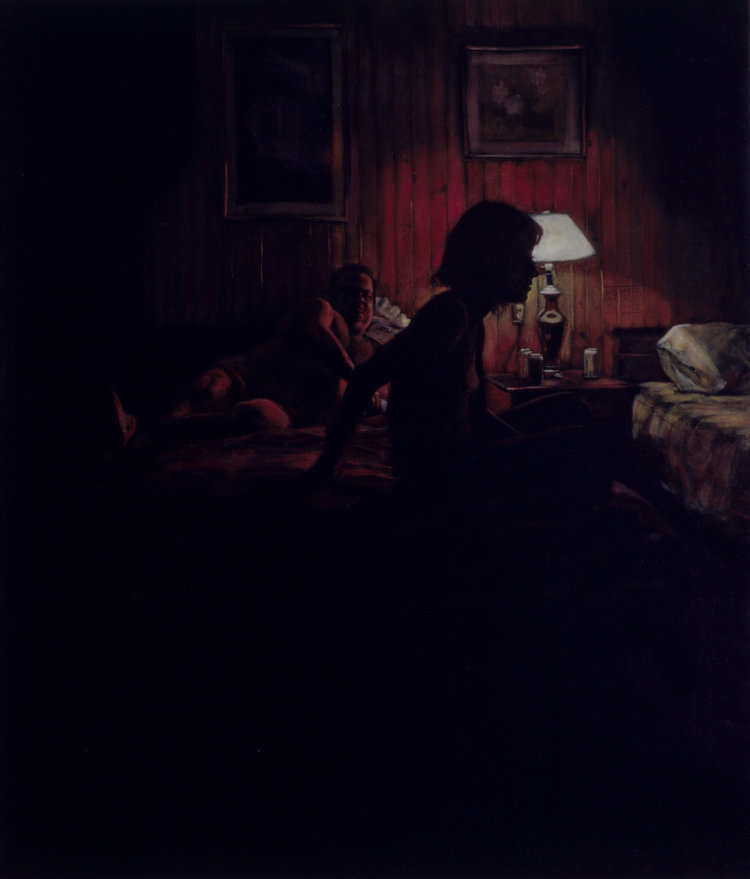
Taking Your Shit | Tony Shore
REVIEW BY M. SULLIVAN
“They don’t photograph well,” Tony Shore says, laughing, “so I need to get people in front of them.” Looking at the image printed on the press release, then looking at the work itself, it’s easy to see how right he is. Each work is done on black velvet. A harsh source of light softly diffuses to an edge of darkness where it is swallowed into an all-consuming black such that the scenes appear to float as in a vacuum or in a memory. A photo does little to adequately present this reality. The depth and richness of the black velvet, the precision of texture, and the fineness of expression are dimmer if not completely lost in the photocopy. But to truly see these works—they engulf you and are beyond compare.
BLUE COLLAR BALTIMORE: NEW AMERICAN REALISM, shown at the Ethan Cohen Gallery, is a culmination of fourteen years of work that demonstrates Shore’s understanding and love of working-class Americans, as well as his dedication to a medium few have practiced and even fewer have mastered. The subjects Shore chooses are often the downtrodden or the violent, and his use of chiaroscuro evokes the same emotive theatricality of a Caravaggio. The result is a series of works that often feel like tonally darker relatives to the Ashcan School’s oeuvre. But Shore’s signature use of black velvet takes these two styles to their relevant extremes. While velvet is a hallmark of the low-brow, amplifying his subjects’ societal standings, the velvet also absorbs more light than traditional oils or acrylic, allowing Shore’s shadows to be considerably darker. The already dramatic lighting is heightened even more and the physical and emotional realities of the people depicted become more poignant. All the same, the otherwise understated features and ordinary settings stave off any sense of melodrama.

Dialysis | Tony Shore
Three of the paintings form a mini-series of their own: Vacancy, Duke’s Motel, and Date. The first shows the namesake motel off of Pulaski Highway in Baltimore and the latter two depict interiors of rooms at the motel. In the first interior scene, the composition is pushed to the top of the velvet and the bottom is left black, forcing you to look up. A man with a pot-belly and a red trucker cap reclines in the bed on the right, relaxing, while a woman sits on the bed to the left, taking off her shoes. The purely black expanse of the painting remains impossible to ignore, overwhelming you with its brazen emptiness, and provoking an uneasy feeling bordering on anxiety.
The second interior is similar, though, with marked differences. There is graffiti on the wood-paneled walls, the bed on the right is empty, the man is naked, a little smug, and even though the woman sitting on the bed with him is almost entirely in silhouette, her stare is unmistakably blank, and her slightly parted lips reveal her disquiet.
Shore mentions that Date was inspired by his Uncle Jimmy, who knew every prostitute in Baltimore. “Uncle Jimmy’s Harem,” they called it. But Shore is not casting judgment when he says this. And I notice that in both these paintings the lamp glowing on the nightstand between the beds creates a halo-like light around the women, elevating them from sinful to angelic.

Date | Tony Shore
When he talks, Shore is very convivial. Holding a pale ale and wearing jeans and a gray flannel, he is an ambassador for the everyman he portrays as well as a relief in a roomful of finely-dressed art-scene regulars. When asked about his work, he focuses on the hours he commits, the quality he pursues, the unrepeatability of his paintings, and the difficulties he endures. In particular, he emphasizes how unforgiving velvet is—how he can’t correct, how he’s thrown out works that were three-quarters of the way finished simply because there’s no way to change them, and how highlights are achieved by painstakingly building up layers and layers of paint. Because of all these drawbacks, he imposes constraints on himself in an effort to ease the pains, meticulously planning each piece. He says it all causes him a lot of stress and jokes that copycats are welcomed “if they’re willing to put up with the shit I put up with.”
Working with constraints naturally causes stylistic choices that Shore otherwise may not have intended or pursued. Referring to the painting Glass Upholstery, he tells us that the puddle reflecting the neon light was actually less strictly planned and that it was freeing to paint. Within the water’s wake, we see some of Shore’s more instinctive tendencies—the swifter brush strokes, the murkier colors.
The scene was staged for Glass Upholstery, though not all of the paintings were. Shore gestures to the disturbing fight scene, Fucked-Up, and says people tell him he’s horrible for just standing there and painting it. Learning that there are staged scenes may seem surprising, may seem to contradict the fact that it’s realism. In fact, Shore goes on to further alter what he sees, blending key features from separate photos to achieve a truer, more intensely real composition. “Her hand was originally flared out, and I put it in her pocket,” Shore says, to give an example.
The emerging ambiguity between what was and what is shown is inescapable in the exhibit. In Dialysis, is the man straining to sit or to stand? is Aunt Nellie crying, yawning, smiling? In Taking Your Shit, the red and blue glare of police lights blend together and form a haze over the scene as two youths begin to fight, suggesting what may happen next, but still leaving it unresolved. A painting has no end, after all, and, unlike a novel or a poem, it cannot have an end. All of these snapshots, these glimpses of limned figures, are merely beginnings. When we look at them they stir in us interpretations but, unmistakably, whatever we feel we know, nevertheless, remains unknown.
Though, what would realism be without that sense of ambiguity which like an ineffable fixture accompanies us in our own daily lives? Where there is sadness, there once was joy that lingers still, where there is ugliness, there is an unappreciated beauty, and where clarity appears, there is also newly revealed obscurity.
Blue-Collar Baltimore: New American Realism will be on view at Ethan Cohen Fine Arts, October 17 – November 16, 2019. Learn more about the artist.
__
M. Sullivan lives in Brooklyn.
![[PANK]](https://pankmagazine.com/wp-content/themes/pank/assets/images/pank-logo-large.png)
